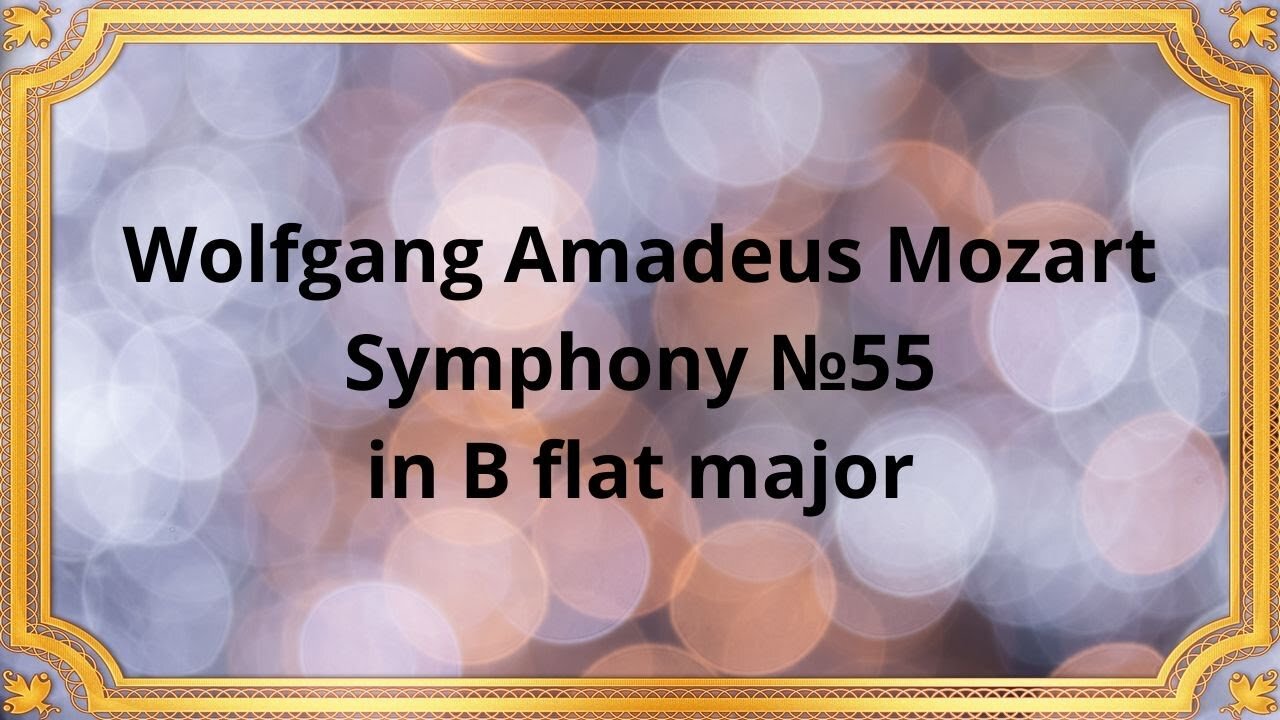Premium Only Content

Wolfgang Amadeus Mozart Symphony №55 in B flat major
#Mozart#Chamber_music#Classical_music#Symphony#Musical_composition
Wolfgang Amadeus Mozart is a celebrated composer who left a legacy of timeless music that continues to inspire audiences worldwide. One of his notable works is Symphony No. 55 in B flat major, a masterpiece that exemplifies his skillful use of orchestration and dynamic contrasts. In this article, we'll take a closer look at this remarkable symphony, exploring its key features and why it remains a standout piece in the classical music canon.
Mozart's Symphony No. 55 in B flat major: An Overview
Symphony No. 55 in B flat major is a three-movement work for a full orchestra. It was composed by Mozart in 1774 when he was just 18 years old. The symphony begins with a lively Allegro that features a series of catchy themes and virtuosic flourishes for the orchestra. The second movement is a serene Andante, with a delicate theme that is passed back and forth between the various sections of the orchestra. The final movement is a sprightly Allegro, with a jaunty melody and intricate counterpoint that showcases Mozart's mastery of orchestration.
Mozart's Symphony No. 55 in B flat major is a significant work in his oeuvre, as well as in the wider classical music tradition. It is known for its intricate harmonies, dynamic contrasts, and engaging melodies, which showcase Mozart's skillful use of orchestration and counterpoint.
The symphony's popularity is due in part to its accessibility and engaging melodies. The catchy themes in the first and third movements, in particular, have become beloved staples of the classical music canon. Additionally, it is a piece that is both challenging and approachable, making it a popular choice for both performers and audiences alike.
Whether you are a seasoned classical music fan or a newcomer to the genre, Symphony No. 55 in B flat major is a must-listen. Its engaging melodies, intricate harmonies, and dynamic contrasts make it a fascinating and enjoyable work to explore. Additionally, its historical significance and enduring popularity make it a valuable addition to any music collection.
Moreover, Symphony No. 55 in B flat major is an excellent example of Mozart's skill and creativity as a composer. It showcases his mastery of orchestration and dynamic contrast, as well as his ability to create engaging melodies and harmonies that have stood the test of time.
Conclusion
Mozart's Symphony No. 55 in B flat major is a masterpiece that exemplifies his skill as a composer. Its engaging melodies, intricate harmonies, and dynamic contrasts make it a significant work in the classical music tradition. Whether you are a longtime classical music fan or a newcomer to the genre, this symphony is a must-listen, and a valuable addition to any music collection.
-
 24:30
24:30
Classical music_Music Inspiration
10 days agoFranz Schubert Grand Duet for Piano Four Hands, Op. 140
451 -
 LIVE
LIVE
TheSaltyCracker
13 minutes agoThey Killed Her ReeEEEe Stream 04-27-25
8,809 watching -
 LIVE
LIVE
Nerdrotic
2 hours ago $2.82 earnedDiscoveries From Graham Hancock's "Fight for the Past" | Forbidden Frontier 099
993 watching -
 LIVE
LIVE
Sarah Westall
1 hour agoHidden Tech Resembles Star Trek: Malaysian Airline, Portals & Wormholes w/ Ashton Forbes
594 watching -
 LIVE
LIVE
Due Dissidence
9 hours agoTrump's Polling COLLAPSES, WI Judge ARRESTED, Biden DRAGGED at WHCD, Corporations PULL Pride Funding
1,261 watching -
 LIVE
LIVE
EricJohnPizzaArtist
1 hour agoAwesome Sauce PIZZA ART LIVE Ep. #45: Tony the Cat!
132 watching -
 LIVE
LIVE
OhHiMark1776
2 hours ago🟢04-27-25 ||||| Halo Multiplayer Rumble: No. 13 ||||| Halo MCC (2019)
170 watching -
 15:05
15:05
Stephen Gardner
1 day ago🔥BREAKING: Trump HAMMERS Zelensky after Kicking France's Macron from meeting about Ukraine!
83.8K294 -
 LIVE
LIVE
AirCondaTv Gaming
3 hours agoSchedule I & Halo - Hustle Hard to Play Hard Later. May the TBags Flow Collab)
37 watching -
 53:29
53:29
Professor Nez
4 hours ago🚨🇺🇸 President Trump MAKES HISTORY! The REAL Story of His First 100 Days!
28.9K71